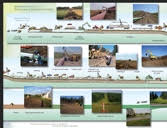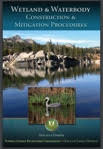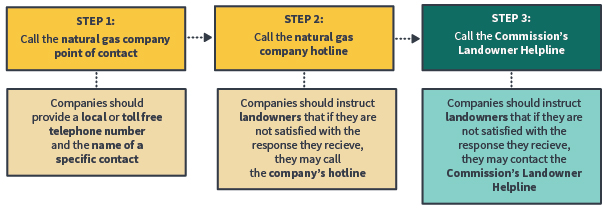Natural Gas Project Landowner/Stakeholder Topics of Interest
FERC considers applications from natural gas companies for construction and operation of interstate natural gas pipelines, storage facilities, compressor stations, other natural gas infrastructure, and liquefied natural gas (LNG) terminals. In addition, FERC monitors the construction of natural gas projects to ensure compliance with environmental conditions required by the Commission.
If the natural gas project is on or abuts your land, as a landowner, you likely will first hear of it from the Natural Gas Company as it begins negotiations for use of your property and/or collects environmental information required for its application to the Commission. If you are interested in a proposed natural gas project, as a stakeholder, you may first learn of it through newspaper notices. The Q&As and the links on this page are intended to guide you to information and resources to help you understand FERC’s role, how you may participate in a FERC proceeding, and how to resolve disputes that arise during construction.
Review of natural gas projects is a multi-step process that provides landowners and stakeholders several opportunities to comment on a proposed project. Some natural gas companies take part in the Commission’s voluntary Pre-filing Process, where natural gas companies and Commission staff discuss the project with stakeholders and environmental issues are identified prior to the filing of an application. This diagram provides a high-level outline of the steps in FERC's process.
FERC Natural Gas Certificate Process

If a proposed pipeline route is on or abuts your land, or if your property is within one-half mile of a proposed compressor station or LNG facility, you will first learn of the project from the natural gas company as it plans and studies the route during either the Commission’s voluntary Pre-filing Process or in the application development process. The “An Interstate Natural Gas Facility on My Land? What Do I Need to Know?” brochure provides answers to many frequently asked questions about natural gas projects, your rights, and the FERC process.
Why would a natural gas pipeline company conduct field surveys and request survey access on my land, and how does FERC use the information gathered during field surveys prior to issuance of a FERC certificate?
Information on Landowner Access to Conduct Field Surveys for Natural Gas Project

You should first contact the natural gas company proposing a project to learn more about project-specific information. Each project under consideration by FERC has a Docket Number, a unique case number that FERC assigns to the project that identifies the project throughout the FERC process. You can search eLibrary, FERC’s database of documents filed with and issued by the Commission, to learn more about the project, review the application and other information submitted by the applicant, review any comments that have been filed, and find documents issued by the Commission.
eLibrary Search
If you need further assistance with eLibrary, you can call the numbers below:
| eLibrary Assistance: eLibrary Help Desk Phone: 202-502-8423 Email: [email protected] |
General Questions about the Commission: Office of External Affairs Telephone: 202-502-8004 Toll-free: 1-866-208-3372 Email: [email protected] |
As a member of the public, you have the right to participate in the FERC process by filing your comments on the project and/or by attending any public scoping/comment sessions that may be held by FERC. All comments, including those filed or given at public scoping/comment sessions will be evaluated and addressed in the environmental review document or the Commission decision document.
- Find out how to get involved in the FERC process. How Can I Get Involved? | Guide to Electronic Information
- Discover if there are any FERC scoping or comment sessions in your area. Calendar
- Get project specific notifications from the Commission by mail or e-mail. eSubscription | Be added to a mailing list
- Provide a comment on a FERC project. eFiling
- Read FERC’s Recently Published Environmental Documents. Environmental Documents
Individuals also have the option to intervene in Commission proceedings. Intervenors become participants in a proceeding and have the right to request rehearing of Commission decision documents and seek relief of final agency actions in the U.S. Circuit Courts of Appeal. Learn what it means to be an intervenor. Intervene
To find information on the federal and state agencies involved in a specific natural gas project that is under review by the Federal Energy Regulatory Commission, the information below covers scenarios when project sponsors:
- use the Commission’s Pre-filing Review Process, prior to filing an application; and
- File an Application with the Commission.
Pre-filing Review Process
The pre-filing process allows Commission staff and stakeholders to get involved during the early project planning phase. It is mandatory for liquefied natural gas (LNG) facilities and voluntary for other natural gas projects. A project sponsor will file a pre-filing request letter with the Commission that must provide a list of the relevant federal and state agencies in the project area with permitting requirements. The list will include contact information, whether the agencies have agreed to participate in the process, and planned permit application dates.
Interested parties may access the pre-filing request letter to obtain information on agency contacts by searching the Commission’s eLibrary system, using a project’s docket number (a unique reference number for each case or application filed with the Commission). Pre-filing projects are assigned a docket number starting with PF. The pre-filing request letter will be the earliest dated document in the PF docket. Typically, the pre-filing request letter includes an attached table that includes agency contacts.
After completing the pre-filing process, a project sponsor will file a formal application, as described in the Application Review Process.
Application Review Process
When a project sponsor files an application for a natural gas project, the Commission assigns a docket number starting with CP. The application must include information regarding the federal and state permits and agencies that will be involved in reviewing the project. This information may be found by accessing the project application from the Commission’s eLibrary system, using the project docket number and appropriate date range. The application will be the earliest dated document in the CP docket. The application may be separated into several individual files. The following file names or document headings should be accessed to identify agency contacts:
- Exhibit F-1 – environmental report: This is comprised of individual environmental resource reports and will include:
- agency contacts that were cited or relied upon to prepare each report (this may be found as a list of references for a resource report);
- correspondence with various agencies, often entitled “Agency Correspondence” (this is typically an appendix to resource report 1 or divided by resource area and included in the respective resource report);
- a list of authorizations required to complete the proposed action and the status of applications (this is typically a permit table in resource report 1 – see below example);
- Exhibit J (for interstate facilities) and Exhibit H (for import/export facilities) – federal authorizations: Exhibits J and H identify each federal authorization that the proposal will require; the agency or officer that will issue each required authorization; the date each request for authorization was submitted; and the date by which final action on each federal authorization has been requested or is expected.
Example of an environmental permit table
Other Options for Finding Agency Contacts
In addition to documents on the Commission’s eLibrary system, there is a Federal Infrastructure Permitting Dashboard that includes certain larger, more complex projects under the following categories:
- Projects Identified as Covered Projects under Title 41 of the Fixing America’s Surface Transportation (FAST) Act (project that involves the construction of an interstate natural gas pipeline or liquefied natural gas terminal that is subject to NEPA and is likely to require a total investment of more than $200,000,000); and
- Major Infrastructure Projects as defined in Section 3(e) of Executive Order 13807 (defined as projects for which multiple authorizations by federal agencies will be required and the lead federal agency has determined that it will prepare an environmental impact statement).
Projects covered under FAST-41 and/or Major Infrastructure Projects are required to list contacts for the agencies on a Permitting Dashboard. The Federal Infrastructure Permitting Dashboard, including a list of covered projects, can be found at https://www.permits.performance.gov/projects and can be further narrowed down by searching by lead agency or project name.
If a natural gas company receives authorization (i.e. approval) from FERC, as well as receives all necessary permits from other applicable agencies, acquires the required easements, and meets the pre-construction conditions of the FERC authorization, the natural gas company can begin construction of the natural gas project.
A natural gas company will first attempt to negotiate an easement – the legal right to use a landowner’s property for the purpose of building and/or operating natural gas pipeline facilities – with landowners, including compensation for use of the land. An easement gives the natural gas company the right to use the property, but the landowner retains the legal title or ownership of the land itself. If the Commission approves a proposed natural gas project, but the natural gas company cannot reach an agreement with a landowner, the Natural Gas Act, enacted by Congress, gives the natural gas company authority to obtain the easement by the exercise of the right of eminent domain. In such circumstances, eminent domain proceedings are initiated by the natural gas company in the federal district or state courts, and the court determines just compensation to the landowner.
FERC has no involvement in eminent domain proceedings.
Below are some helpful links if you think you may be affected by, or are interested in, the construction of natural gas facilities.

|

|

|
|
Learn about construction and operation Construction Diagram 
E-Learning Modules |
FERC’s Pipeline Construction and Restoration Requirements in Upland Areas Guide | FERC’s Pipeline Construction and Restoration Requirements for Wetlands and Waterbodies Guide |
How Do I Resolve an Environmental Concern During Construction?
Natural gas companies may provide environmental complaint resolution procedures to landowners for projects under construction and during restoration of the right-of way. If you have difficulty contacting a pipeline company and/or resolving a dispute, the FERC Landowner Helpline staff can help.
The FERC Landowner Helpline, managed by the FERC Dispute Resolution Service, facilitates communication between landowners and natural gas companies. FERC Landowner Helpline staff are neutral and independent professional mediators who do not advocate positions, conduct investigations for the Commission, or provide legal advice. They assist landowners with:
- Construction-Related Concerns and Damages from interstate natural gas transmission and storage projects and LNG projects
- Land Access Disputes
- Executed Easement Disputes (pre-existing easement agreements)
- Land Restoration Disputes (revegetation, settling or subsidence, erosion, or drainage)
- Noise and/or Vibration Complaints
When calling the FERC Landowner Helpline, please, if known, have the project’s docket number, the name and location of the project, and the name and contact information for company officials you have been previously working with. This will help FERC staff better address your concerns.
FERC Landowner Helpline
Local: 202-502-6651
Toll-free: 1-877-337-2237
Email: [email protected]

Public Safety
If you smell gas, please evacuate the area and call 9-1-1.
If you have other public safety concerns regarding an operational pipeline, contact the Community Liaison Services at the Pipeline and Hazardous Materials Safety Administration of the U.S. Department of Transportation. Visit http://www.phmsa.dot.gov/comm/cats.htm for contact information based on your location.
State Utility Responsibilities
The activities listed below are generally regulated by the states. Please contact your appropriate state agency, such as the state public utility commission, for more information:
- Intrastate or Local Distribution Natural Gas Pipelines – Pipelines that are located entirely within one state are generally regulated by that state.
- Utility Bill Disputes
- Oil Pipeline Siting
- Oil and Gas Production
- Electric Facility Siting

For bulk orders of this Brochure go to GPO Bookstore
If you wish to have this Brochure printed yourself please download this version
February 25, 2020 - FERC Looks to Speed Landowner Rehearing Process. Recorded February 12, 2020
Guests Holly Cafer and Joshua Hurwitz of FERC’s Office of General Counsel discuss FERC’s new efforts to improve the rehearing process for landowners affected by natural gas projects, and about landowners assistance options from the FERC Dispute Resolution Service and its Landowner Helpline.
Contact Information
-
Office of External AffairsTelephone: 202-502-8004Toll-free Telephone: 1-866-208-3372Email: [email protected]
-
FERC On-Line SupportEmail: [email protected]
-
FERC Online SupportEmail: [email protected]
-
If You Smell Gas:Evacuate and Call 9-1-1 (Emergency Assistance)
